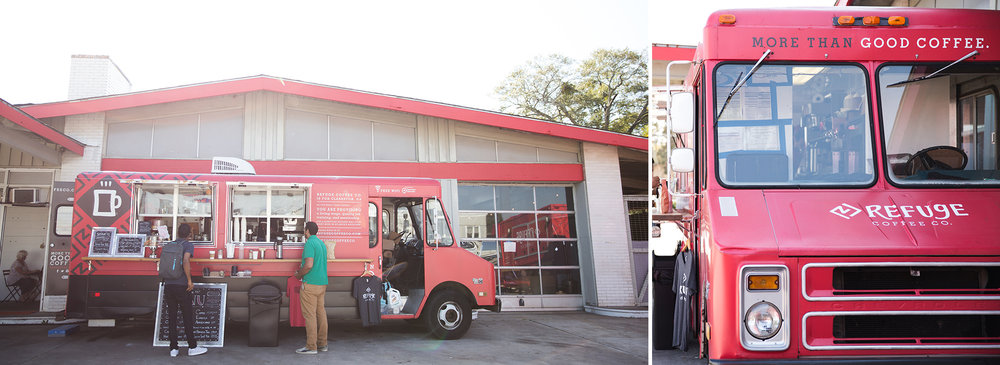Want to understand what type of gas mileage you’ll get with a food truck? As a truck owner, fuel costs are a crucial part of your daily expenses and can greatly affect your weekly budget. If you’re new to the business, it’s important to understand what these costs might look like for you. In this article, I share insights into the amount gas you’ll need to operate a food truck for transportation and generator operation.
Of course, how much gas a food truck requires to operate will depend on the type of weight, distance, and driving conditions you go through. With that being said, here are some rough estimates based on the average gas mileage of popular food truck models.
- Step Vans:
- Freightliner MT45: Typically, step vans like the Freightliner MT45 get about 8-12 miles per gallon, depending on the engine type and the load they carry.
- Ford P-Series: Similar to other step vans, the Ford P-Series usually averages between 8-12 miles per gallon. The fuel efficiency can vary based on factors like weight, engine condition, and whether the vehicle is traveling in city traffic or on highways.
- Sprinter Vans:
- Mercedes-Benz Sprinter: Sprinter vans are generally more fuel-efficient compared to traditional step vans. A Mercedes-Benz Sprinter can get between 15-20 miles per gallon, with newer models and those with diesel engines at the higher end of this range.
- Ford Transit: The Ford Transit is comparable to the Sprinter in terms of efficiency. Depending on the model and engine type, a Transit can achieve about 14-19 miles per gallon.
- Box Trucks:
- Chevrolet P30: This classic food truck model usually sees lower fuel efficiency, getting around 8-12 miles per gallon. The exact mileage can depend heavily on the vehicle’s condition and how well it’s been maintained.
- GMC Step Van: Very similar to the Chevrolet P30, the GMC Step Van also gets about 8-12 miles per gallon. As with other heavy-duty vehicles, efficiency is influenced by factors like load and driving conditions.
- Trailers:
- Airstream Trailers and Custom-built Trailers: Trailers themselves do not consume fuel as they are towed by other vehicles. However, the towing vehicle’s fuel efficiency is impacted by the additional weight and aerodynamics of the trailer. Generally, towing a trailer can reduce the towing vehicle’s mileage by 2-5 miles per gallon depending on the size and weight of the trailer.
These estimates provide a general idea of what to expect in terms of fuel consumption for different types of food truck vehicles. Choosing the right type depends on factors including the route, typical distances traveled, and budget considerations for fuel costs.
Relying on Estimates?
If one is relying on the estimates online concerning ‘food start-up’ costs and the like, they would likely be lead to believe, through figure calculation, that they’d end up burning at least a 10-gallon tank’s worth of gas every day. Give or take.
Perhaps if one was also calculating fuel used via generator [which shall be mentioned in a bit], that could be possible; I on the other hand cannot imagine that to be even close to reality unless in the notably disadvantaged position of having to drive HEAVILY long distances every day towards your parking destinations; a-la those food trucks who will drive to whole different cities if not across a nearby state border. Even with the added gas requirements that larger vehicles such as buses, hummers, and food trucks may incur, the average business which SHOULD have their food truck set up at a somewhat reasonably close[ish] location to their selling area should not be using that much fuel purely on driving every single day. Then again, there are notes that many of the BIGGER trucks are of that kind that can only get 4-5 miles to the gallon… so there is THAT.
That said, most regular food trucks will run on a rate of 10 miles to the gallon at the very WORST. And if you’re a smaller operation based out of a van or a cart being pulled by a truck, then much more regular mileage rates will of course be applied. As for distance, truly there’s no average even close to that, especially when considering just the random extra events, special seasonal locations, and other spots which a truck has to go to during the year that don’t apply towards their daily routine.
What HAS been heard, here and there, are a few average truck owners, working 25 days a month, mentioning that they’re 20 gallon tank, on average, only needs refilling once per week. Assuming the not-so-friendly-but-maybe-average scenario of a 10-miles-per-gallon tank, that’s to say an average truck stationed at a commissary somewhat ‘close’ to ‘downtown,’ or wherever, is likely driving somewhere between 30-40 miles a day, give or take. From here one can take their own situation; tank size, gas mileage, location, etc, and adjust their expected situation as it occurs.
Not too detailed I know, but that’s gas, as we know. But there ARE a few other considerations to be aware of on the subject to help reduce and calculate the costs.

Refuge Coffee Co. Truck built by M&R Specialty Trailers and Trucks.
Gas vs Diesel
When choosing between diesel and gasoline engines for a food truck, each option comes with its own set of advantages and disadvantages.
Generator Factor
Food trucks need generators to power the various kitchen appliances they use to cook and serve food. These appliances might include refrigerators, freezers, grills, ovens, and lights, which require a lot of electricity—more than what the truck’s standard battery system can provide. Since food trucks are mobile and often operate in places without direct access to electrical outlets, generators are essential for providing the necessary power.
The amount of fuel a food truck generator needs depends mainly on two things:
- Size and Type of Generator: Generators come in different sizes, measured in kilowatts (kW). The more powerful the generator, the more fuel it consumes. A typical food truck might use a generator ranging from 4 kW to 12 kW.
- Duration of Use: The longer the generator runs, the more fuel it will use. Fuel consumption also depends on how many appliances are being powered at once and how much power each appliance needs.
Example: A common estimate for a generator’s fuel consumption is about 0.5 gallons of gasoline or diesel per hour for a small generator. If a food truck runs a medium-sized generator (around 7 kW) for about 4 hours during a lunch or dinner rush, it might use about 2 gallons of fuel each session.
Fuel-Saving TIPS
Fortunately, there are several effective strategies you can implement to keep these costs under control. Here’s how you can shift your operations towards the lower end of the fuel consumption spectrum:
Stay on Top of Maintenance
A well-maintained food truck is an efficient food truck. Regular checks and upkeep can prevent the small issues that lead to big fuel wastes. Keep your wheel alignment straight and ensure that every component of your vehicle is in top-notch condition. Even something as simple as an under-performing engine can lead to increased fuel use because it has to work harder to get you moving.
Keep Those Tires Pumped
Proper tire inflation is more crucial than it might seem. Under-inflated tires create more resistance on the road, which means your engine has to expend more effort—and more gas—to keep you rolling. Check your tire pressure regularly, and keep it set to the ideal level recommended for your vehicle.
Ease Off the Gas
Did you know that driving speed significantly affects your fuel efficiency? Keeping your speed at 55 mph or lower is optimal. Higher speeds mean the engine has to burn more fuel to overcome air resistance. Also, try to avoid sudden braking and rapid accelerations as much as possible. Smooth driving is not only safer but also more fuel-efficient.
Find the Best Fuel Prices
Take advantage of apps and websites like GasBuddy, which help you locate the lowest fuel prices in your area. Prices can vary dramatically between different stations; by choosing the cheapest available, you can significantly reduce your fuel expenses over time.
Plan Your Routes Wisely
Last but not least, efficient route planning can save you both time and fuel. Opt for the shortest, most straightforward routes to your destinations, and try to avoid heavy traffic times and areas where you might be stuck idling for long periods.
By taking these steps, you can maximize your food truck’s fuel efficiency, lowering your operating costs and boosting your overall profitability. Remember, in the food truck business, every little bit of savings counts, and reducing your fuel consumption is a great way to start trimming expenses. Happy driving!

